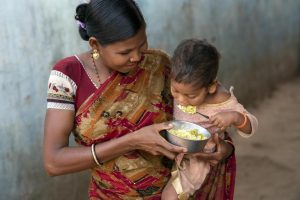Malnutrition is a major public health emergency in India today, with about 50% of the population suffering from it in some form - protein-calorie deficit and/or micro-nutrient malnutrition. It is the underlying cause of at least 50% of deaths of under 5 children in the country. Even if it does not lead to death, malnutrition including micronutrient deficiencies, often leads to permanent damage including impairment of physical growth and mental development, and to added health care costs to the State. The nutrition scenario in Karnataka compared to other Southern States is also a cause for concern. Relevantly, evidence from three published papers by the Author on ‘Multisectoral Nutrition Interventions and Their Impact’ clearly shows the expected improvement in the nutritional status of children and adolescent girls, improvement in pregnancy weight gain and reduction of low-birth weight babies. But the data analysis has also thrown up some new findings which relate to the transitions between wasting, stunting and underweight among children during intervention period, and the role of height in perpetuating/transitioning to wasting among children and acute thinness among adolescent girls, also during intervention period. Find a Summary Note here including what the Author believes are areas for further research
By Ms. Veena S Rao, IAS (Retd)
Director, Auro Centre for Public Nutrition, Public Health and Public Policy
Bangalore, India
Karnataka Multisectoral Nutrition Pilot Project (2014-2018)
Some Significant New Evidence Based Findings and Need for Further Research
The Karnataka Multisectoral Nutrition Pilot Project (KMNPP) was implemented under the leadership of the Karnataka Comprehensive Nutrition Mission (KCNM), announced by the State Government in 2010. The interventions followed the intersectoral-intergenerational strategy and addressed the root causes of undernutrition in India, namely, dietary deficit, information deficit and the market deficit. Government of Karnataka received a grant of USD 4.55 million from the World Bank/ JSDF Trust Fund, in July 2014 for replicating the strategy in two of the most backward Blocks in Karnataka—Devadurga Block, Raichur District and Chincholi Block, Gulbarga districts. The project ended in September 2018.
Real-time monthly/quarterly anthropometric data of the target groups, viz., children 0-3 years, adolescent girls 11-18 years, and pregnant and nursing mothers was recorded and monitored. Three papers have emerged from this real time data which have been published in Indian Journal of Human Development in 2022 and 2023:
- a) Multisectoral Nutrition Interventions and Their Impact on the Nutritional Status of Children: An Open Experiment in Two Remote Blocks of Karnataka, India[i]
- b) Multisectoral Nutrition Interventions and Their Impact on BMI and Thinness Levels Among Adolescent Girls: An Open Experiment in Two Remote Blocks of Karnataka, India[ii]
- c) Multisectoral Nutrition Interventions and Their Impact on Pregnancy Weight Gain and Low Birth Weight: An Open Experiment in Two Remote Blocks of Karnataka, India[iii]
Evidence from the three papers shows the expected improvement in the nutritional status of children and adolescent girls, improvement in pregnancy weight gain and reduction of low birth weight babies. Not surprising, because the objective of the project was to bridge the dietary deficit and the information deficit, which it successfully did.
However, some new evidence-based findings have also emerged from the data analysis:
- There is constant inter-indicator transition between stunted, underweight and wasted children. Stunting becomes a catchment area for improved wasted and underweight children, even as stunted children improve and become non-stunted. This transition is not trackable or discernible in periodic, cross-sectional surveys like the NFHS.
- Another interesting finding that emerged was that children with higher baseline height were more vulnerable to wasting. Some examples: From the stunted category, taller children with higher height gain and lower weight gain became severely wasted; shorter children with poor weight gain developed severe underweight. From the wasted category, taller wasted children with lower weight gain remained wasted, taller children with optimal weight gain became normal, and those children who gained constant weight and poor height gain transitioned into the stunted category.
- Similarly, among adolescent girls, moderate thinness became the catchment area for improved severely thin girls and deteriorated normal girls. And again, height at baseline and height gain during the project period appears to be a critical determinant of their BMI status and transition. Some examples: Girls who were moderately or severely thin at baseline and remained moderately or severely thin were taller than those who were normal at baseline. The severely thin girls who remained severely thin at endline were the tallest (152.6 cm at baseline and 155.9 at endline). Girls who were severely thin at baseline and became normal at endline were the shortest (147.8 at baseline and 150.7 at endline). Moderately thin girls who became normal with no thinness at end line, had the maximum baseline height (146.8cm), and their height gain during the entire project duration was lowest at 5.1cm and weight gain was highest 8.3kg. Among moderately thin girls, the shortest girls (142.7cm) who gained highest height gain (14.4cm) and who had the lowest baseline weight (29.8 kg) and the lowest weight gain (3.8 kg) became severely thin.
- A new finding that emerged from the data on low birth weight: As the mother’s BMI at the time of pregnancy confirmation increases, there is a corresponding decrease in per cent LBW, and a corresponding increase in mean birth weight. There is a positive and significant association between the BMI of women at pregnancy confirmation and the higher birth weight of their newborns, as is evident in terms of Pearson Correlation Coefficient +0.15 (p < 0.008)
Further research required
The constant transition between wasting, stunting and underweight among children suggests that they impact each other constantly and coexist simultaneously in different combinations as children grow. Hence, policy and programmes for addressing/preventing them, should view them in an integrated, holistic manner. It is also important to understand the details, sequence and duration of these transitions, so that statistical models can be drawn up for setting and achieving scientifically sound targets. Hence, greater research is required regarding the trends, duration and sequence of transitions.
Real time data suggests that the role of height is a prominent determinant for wasting among children and acute thinness among adolescent girls. This requires much further discussion and research, to inform policy makers and academia.
References
[i] https://journals.sagepub.com/doi/full/10.1177/09737030221098979?journalCode=jhda
[ii] https://journals.sagepub.com/doi/abs/10.1177/09737030221135816?journalCode=jhda
[iii] https://journals.sagepub.com/doi/abs/10.1177/09737030231155282
—
By the same Author recently on PEAH
Nourishing India – What Needs to Be Done



